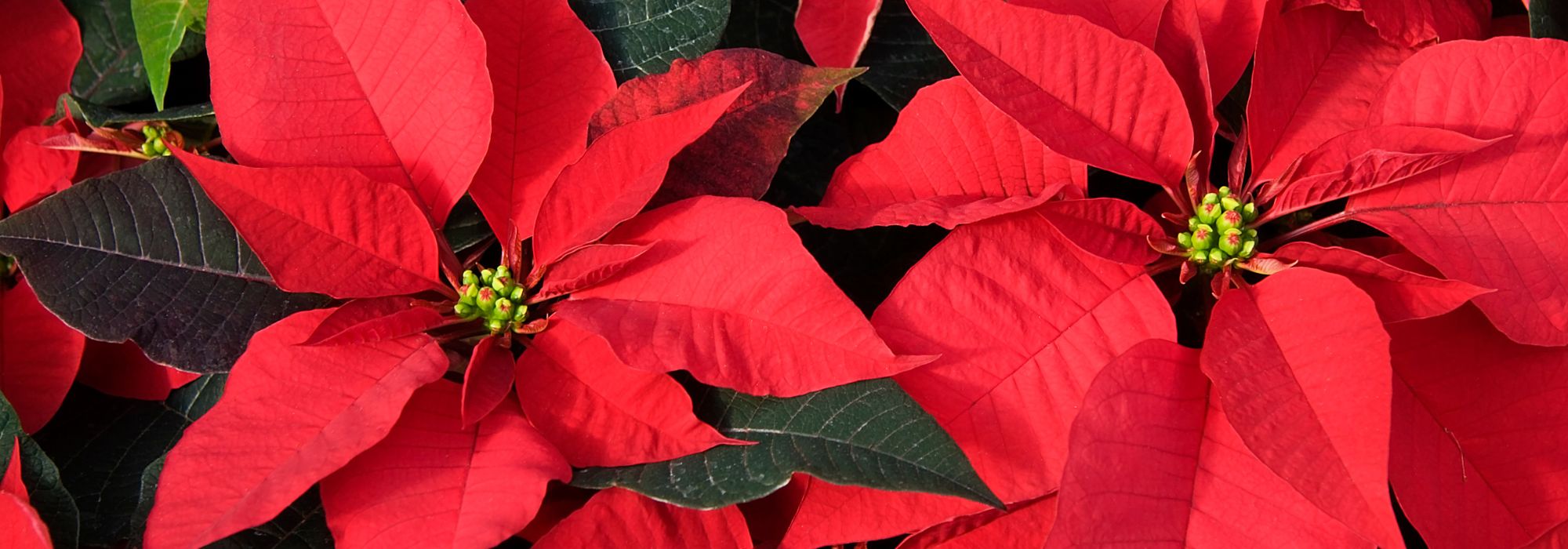
Christmas Star - Poinsettia : growing and caring
Contents
Poinsettia in a Nutshell
- The Poinsettia is a tropical indoor plant, famous for its colourful bracts in winter.
- It thrives in bright light without direct sunlight, a temperature of 18 to 22 °C, and moderately humid air.
- Its soil should be light, rich, and very well-drained.
- Moderate watering and pruning after flowering ensure healthy growth.
- To “reflower”, it requires long dark nights in autumn.
The word from our expert
The Poinsettia, also known as the Christmas Star, is an iconic plant for the festive season. Native to Mexico, Euphorbia pulcherrima belongs to the Euphorbiaceae family and charms with its colourful bracts, often red, white, or pink, which surround its subtle central flowers. In its natural habitat, the Poinsettia grows as a bush reaching several metres in height, thriving in a warm, bright, and slightly humid climate.
Indoors, the Poinsettia is cherished for its ability to brighten up winter with its decorative foliage and winter flowering. It prefers bright but indirect light, temperatures between 18 and 22°C, and a moderately humid atmosphere. The soil should be light, well-drained, and rich, while the chosen pot must ensure good water drainage to protect its roots, which are sensitive to excess moisture.
In terms of care, the Poinsettia requires regular but not excessive watering, allowing the soil to dry slightly between waterings. Light fertilisation in spring and summer promotes healthy growth, while pruning just after flowering helps maintain a dense and balanced habit. To encourage reflowering the following winter, the plant needs precise management of autumn light, with long, dark nights for several weeks.
Decorative and versatile, the Poinsettia fits into many interior styles, whether in a modern ceramic pot, a natural basket, or a large open terrarium. Paired with other plants like fittonias or ivies, it becomes the living heart of festive décor, symbolising warmth, prosperity, and the magic of Christmas for centuries.
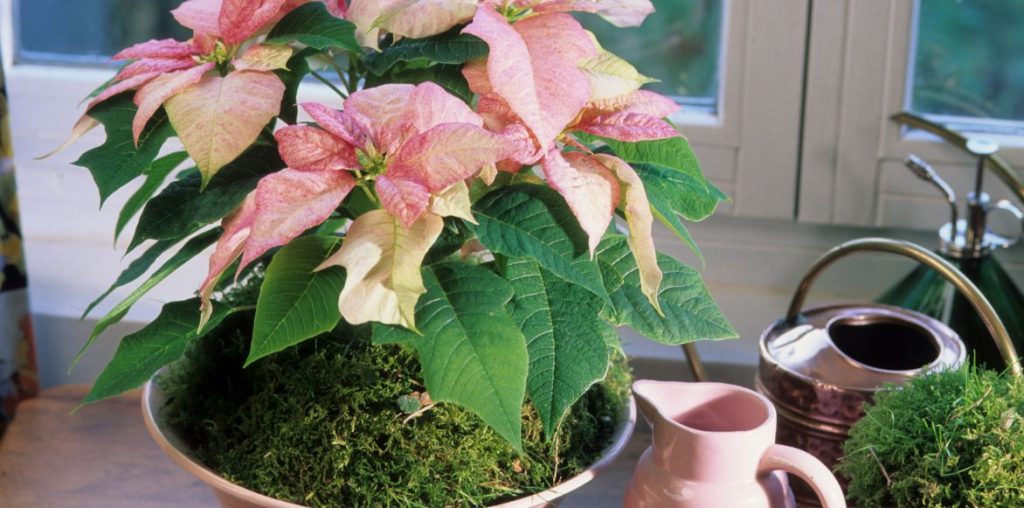
Poinsettias don’t always flower in crimson red. You can opt for softer tones.
Botany and description
Botanical data
- Latin name Euphorbia pulcherrima
- Family Euphorbiaceae
- Common name Poinsettia, Christmas Star
- Flowering December to February
- Height 80 cm
- Exposure bright, no direct sunlight
- Soil type rich and light potting mix
- Hardiness 10°C
The Poinsettia, better known as the Christmas Star, belongs to the Euphorbiaceae family, a large family of plants that includes both tropical plants and succulents. Its botanical name, Euphorbia pulcherrima, literally means “the most beautiful euphorbia,” a tribute to its spectacular coloured bracts, often mistaken for flowers. The genus name Euphorbia comes from Euphorbus, a Greek physician to King Juba II of Mauretania, who is said to have used a plant from this group for its medicinal properties.
In French, it is often called the Christmas Star due to the star-like arrangement of its red bracts (sometimes pink, white, or variegated) and its spectacular “flowering” in winter, just in time for the holidays. Other popular names include simply Poinsettia, named after Joel Poinsett, an American diplomat who introduced the plant to the United States in the 19th century after discovering it in Mexico.
In the wild, the Poinsettia grows in the tropical regions of Mexico and Central America, where it can reach several metres in height. It thrives in a warm and humid climate, at the edge of forests, enjoying good sunlight while being protected from direct and intense rays.
It has become an essential indoor plant in winter, as it adds a splash of vibrant colour during a time when few plants are in bloom. Its ability to flower naturally as the days shorten reinforces its association with Christmas. Moreover, horticulturists have made it more compact, colourful, and suited to pot cultivation.
Among the commonly cultivated varieties, you’ll find classics like ‘Prestige Red’ for its bright red hue, ‘Ice Punch’ with its creamy white highlights, or ‘Pink Champagne’, a softer and more original version. All these varieties have been selected for their pot performance, the longevity of their bract colouring, and their resistance to indoor growing conditions.
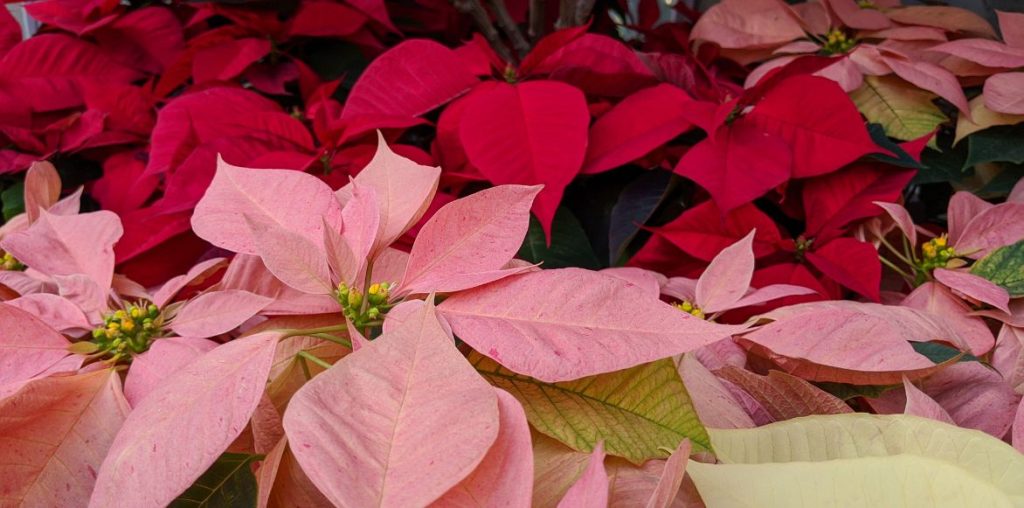
There is now a wide choice in Poinsettia varieties: red, pink, white…
In its natural habitat, the Euphorbia pulcherrima develops as a bush that can reach two to four metres in height, with a rather airy and bushy habit. Grown in pots, it remains compact thanks to regular pruning that stimulates its branching. Its roots are fibrous, quite dense, but shallow; they appreciate a well-drained substrate to avoid excess moisture, which is detrimental to this delicate root system.
The trunk, woody at the base over time, retains flexibility in its young shoots. It is not particularly thick, but it is sturdy and easily supports the foliage and inflorescences. The branches often grow at an open angle, giving the plant the appearance of a small star-shaped tree when well-structured. In some dwarf horticultural varieties, the branching is denser, enhancing the decorative effect.
The leaves, on the other hand, are alternate, oval to lanceolate in shape, with a more or less rounded base and a tapered tip. Their edges can be slightly dentate or smooth, depending on the variety. They are a deep dark green, sometimes tinged with purple in certain selections, and their lamina shows a well-marked vein. It is this foliage that highlights the famous bracts, these modified leaves that colour as flowering approaches.
The flowering is actually quite discreet. At the heart of the coloured bracts lie the true flowers: tiny yellow-green structures called cyathia, typical of Euphorbias. Each cyathium contains male organs and a female flower, but they are almost unnoticed as the bracts draw the eye. In Euphorbia pulcherrima, it is this synchronisation between the formation of the coloured bracts and the cyathia that marks the peak of its beauty.
As for fruiting, it is very rare in indoor cultivation. When it occurs, it produces small trilobed capsules, characteristic of the Euphorbiaceae family. But good sunlight and often manual pollination are needed to hope for them to appear. In the Mexican wild, however, these fruits contribute to the plant’s reproductive cycle, although the Poinsettia is largely propagated by cuttings in horticulture.
Did you know? Native to Mexico, the Poinsettia was already revered by the Aztecs, who used its red leaves to make dyes and its sap for medicinal preparations. Its link to Christmas dates back to the 16th century, when a Mexican legend tells of a young girl who, having nothing to offer the church for Christmas, presented simple wild herbs, which miraculously transformed into magnificent red stars. Introduced to the United States in the 19th century by Joel Poinsett, an ambassador and botany enthusiast, it gradually became an essential symbol of the end-of-year festivities, associated with prosperity, rebirth, and hope.
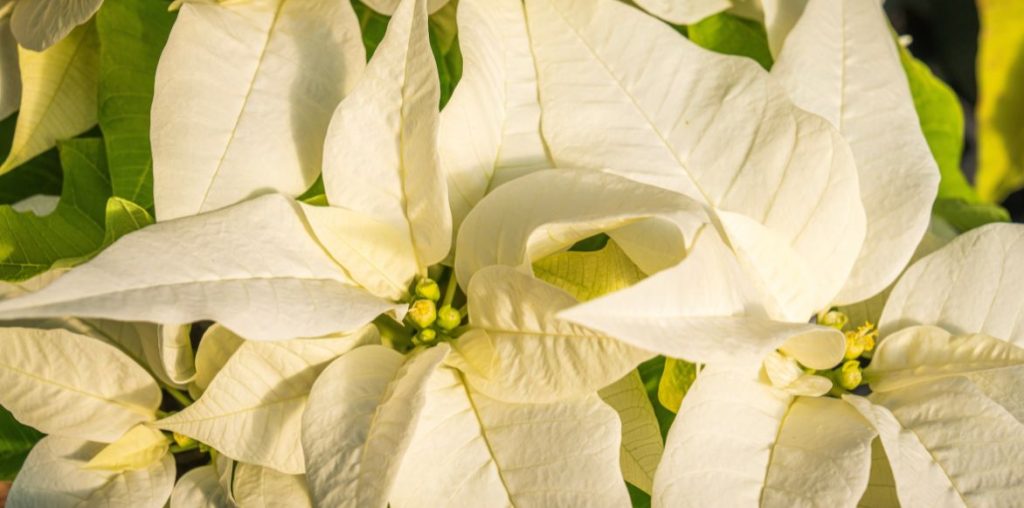
Some Poinsettia varieties reveal white bracts, as in the Euphorbia pulcherrima ‘Alba’.
How to plant the Poinsettia?
When to plant?
Planting a Poinsettia in a pot is best done in spring. The ideal substrate should be light, well-draining, and rich in organic matter; a mixture composed of potting soil for flowering plants, supplemented with perlite or coarse sand, offers a good balance between water retention and root aeration.
Which pot to choose for your Poinsettia?
The choice of pot matters: it should be slightly wider than the root ball, with a diameter about two to three centimetres larger. A terracotta pot is often preferred, as it promotes the evaporation of excess moisture, but a good-quality plastic pot with effective drainage also works very well. In any case, a drainage hole is essential to prevent water stagnation at the bottom of the pot.
Where to place the pot?
The Poinsettia should be placed in a bright spot without direct sunlight, especially in summer, as its leaves are sensitive to scorching. Bright but filtered light is ideal. Indoors, a well-lit room facing east or west is perfect. The ideal ambient temperature is around 18 to 22 °C; below 15 °C, the plant may suffer. Slightly humid air is appreciated, but without excess; a humidity level of 50 to 60% is sufficient, and it is best to avoid cold drafts or sudden temperature changes.
How to plant a Poinsettia?
- Choose a clean pot and place a layer of drainage at the bottom, composed of clay pebbles or gravel.
- Add a little substrate on top of this layer.
- The plant is then gently removed from its original container; it is helpful to lightly untangle the roots if they form a tight ball.
- Position the plant in the centre of the new pot, ensuring the top of the root ball sits just below the rim of the pot.
- Fill the space around the root ball with the prepared substrate, lightly pressing it down by hand to secure the plant.
- A generous watering follows immediately after planting to evenly moisten the soil.
Repotting is generally done every year in spring for vigorous plants or every two years if growth is slower. It allows for the renewal of depleted substrate, checking the condition of the roots, and providing a more suitable space for the plant. During repotting, you can take the opportunity to lightly prune the stems to encourage beautiful branching for the following season.
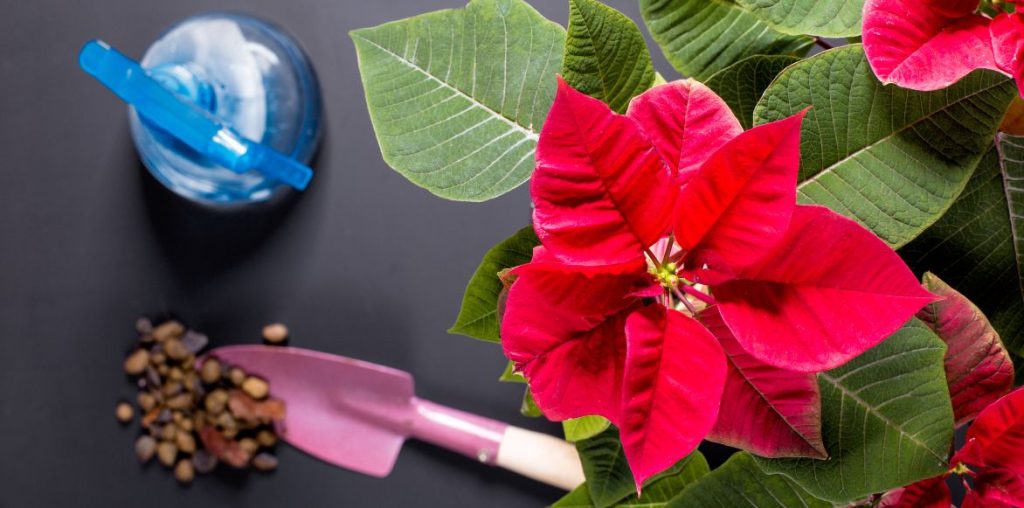
The Poinsettia requires a light substrate and regular watering.
How to care for a poinsettia?
Watering
Watering should be regular but moderate. It is important to allow the surface of the substrate to dry slightly between waterings. Excess water is far more harmful than a slight lack, as it encourages root rot. It is better to water at room temperature, avoiding stagnant water in the saucer; it is often recommended to remove excess water about fifteen minutes after watering.
Fertilisation
Fertilisation is mainly useful in spring and summer, when the Poinsettia is in active growth. A balanced liquid fertiliser for flowering plants, applied approximately every three weeks, stimulates leaf production and prepares the plant for future flowering. During autumn and winter, when the Poinsettia is in its flowering or resting phase, fertilisation is not necessary.
Pruning
Regarding pruning, it is not obligatory but highly recommended to maintain a compact and harmonious habit. After flowering, towards the end of winter or the beginning of spring, it is advisable to prune the stems to about ten to fifteen centimetres from the base. This encourages the emergence of new shoots and results in a bushier plant for the next season. During the growing season, minor maintenance pruning can also be carried out to encourage branching.
Potential precautions
A few precautions should be taken to keep a Poinsettia healthy. This plant is sensitive to cold draughts, which can cause rapid leaf drop. It does not like overly dry atmospheres, common in heated interiors during winter; placing a humidifier nearby or setting the pot on a bed of moist clay pebbles improves its comfort. It is also important to avoid moving the plant frequently, especially during flowering, as this can stress it and lead to premature defoliation.
Finally, although the Poinsettia is often considered a disposable plant after the holidays, it is entirely possible to keep it from one year to the next, provided its natural photoperiod needs are respected if you wish to see it reflower. This involves providing long nights (14 hours of total darkness) for several weeks in autumn.
How to make a poinsettia "reflower"?
After winter flowering, the plant naturally enters a resting phase in spring. It is then advisable to reduce watering, let the substrate dry out more, and stop all fertilisation. In spring, severe pruning is carried out to shorten the stems to about ten centimetres. This stimulates the emergence of new vigorous shoots. Afterwards, the plant gradually resumes regular watering and fertilisation every two to three weeks.
Throughout the summer, the Poinsettia enjoys bright light, without scorching sun, and a mild temperature, between 18 and 25 °C. It can be taken outside, in a slightly shaded spot, as long as the nights remain warm enough.
The secret to reflowering begins at the end of September or early October. The Poinsettia requires a short photoperiod to initiate the formation of its colourful bracts. This means it must receive 14 to 16 hours of total darkness per day for about eight weeks. The slightest exposure to artificial light can disrupt this process. It is therefore recommended to cover the plant each evening with a cardboard box or place it in a dark cupboard, then bring it out in the morning to allow it to enjoy daylight. During this period, the temperature should remain stable, ideally between 18 and 20 °C, and watering should be moderate, without letting the root ball dry out completely.
If everything is followed correctly, colourful bracts will begin to appear after six to eight weeks, just in time for the end-of-year festivities. This process requires discipline, but the satisfaction of seeing a Poinsettia reflower naturally is immense.
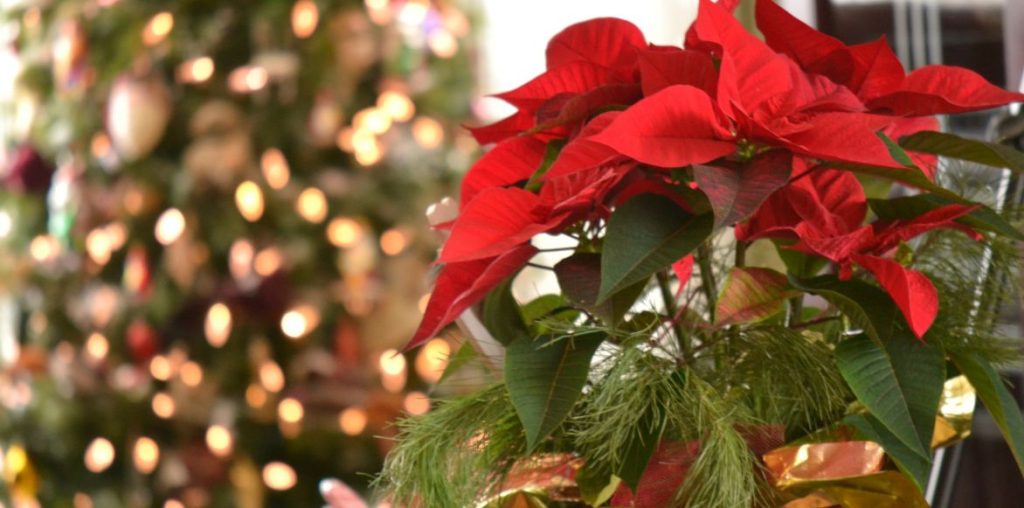
The Poinsettia is a must-have for the end-of-year celebrations. However, it can sometimes be difficult to get it to reflower.
Diseases, parasitic issues, and potential cultivation problems
Parasites
Among the most common enemies of the poinsettia, whiteflies are particularly formidable. These small insects shelter under the leaves and suck the sap, causing a general weakening of the plant. Scale insects, appearing as small cottony masses or brown bark, also settle on the stems and the undersides of the leaves. Less common, spider mites and thrips can also attack, especially in very dry conditions.
To combat them, it is advisable to act quickly. A simple first step is to shower the plant with lukewarm water to mechanically dislodge the insects. Next, applying a natural insecticidal solution based on black soap or neem oil, well diluted, can control light infestations. In case of a severe attack, it may be necessary to repeat treatments a few days apart.
Diseases
Regarding diseases, the Poinsettia can suffer from root rot, especially if watering is excessive or drainage is insufficient. The leaves soften, turn yellow, and then fall abruptly. To prevent this, it is essential never to let water stagnate in the saucer and to use a well-draining substrate.
Cultivation Problems
Yellowing leaves are often linked to overwatering, lack of light, or nutrient deficiency. Reducing watering, moving the plant to a brighter spot, and resuming appropriate fertilisation are usually enough to correct the situation.
Sudden leaf drop is a classic symptom of stress: sudden temperature changes, cold draughts, or frequent relocation of the plant. It is therefore important to maintain a stable temperature, avoid high-traffic areas, and leave the Poinsettia undisturbed once it has found its place.
Another anomaly sometimes observed is the rapid wilting of leaves, even if the soil seems moist. This may signal the onset of root rot or waterlogging; it then becomes urgent to let the substrate dry out completely before watering again.
How to propagate a poinsettia?
Poinsettia propagation is mainly done by stem cuttings in spring or summer, when the plant is in full growth. Simply take cuttings of 8 to 10 centimetres in length, choosing healthy and non-lignified shoots. Each cutting should have at least two to three leaves. After cutting, it is advisable to let the milky sap, characteristic of Euphorbias, flow out by quickly dipping the base of the cutting in lukewarm water to stop the flow.
The cuttings are then planted in a light and very well-draining mixture, made of compost and perlite or sand. A warm (around 22 to 24 °C) and humid atmosphere is essential: it is therefore recommended to cover the pot with a transparent plastic bag or place the cuttings in a mini greenhouse to maintain high humidity while ensuring good ventilation.
Rooting takes about three to four weeks. Once the cuttings show new shoots, a sign that roots have formed well, they can be transplanted into individual pots. From then on, the young Poinsettia is cared for like an adult plant, with moderate watering and bright exposure without direct sunlight.
How to incorporate a poinsettia into your home?
In a modern or contemporary interior, with clean lines and muted colours, a vibrant red Poinsettia creates a striking contrast. It will be perfectly showcased in a white, black, or grey ceramic pot, with a matte or satin finish, enhancing the minimalist elegance of the ensemble. A version with white or pink bracts will also suit a Scandinavian décor, where soft and natural tones predominate.
In a more classic or rustic interior, where raw wood and natural materials take centre stage, the Poinsettia will thrive in a wicker planter, unglazed terracotta, or artisanal ceramic in warm tones. This will evoke its Mexican origins while creating a welcoming and cosy atmosphere.
It is also entirely possible to place a Poinsettia in a large open terrarium styled as a “winter garden,” provided the air circulates freely to avoid stagnant humidity. It can thus be paired with other plants that enjoy bright and temperate conditions, such as ferns or fittonias, for a festive and long-lasting plant composition.
To accompany a Poinsettia, plants like trailing ivy, fittonias, or ferns add lightness and a lovely foliage contrast. During the end-of-year festivities, a few fir branches, pine cones, or eucalyptus arranged around the pot enhance the festive spirit while remaining natural.
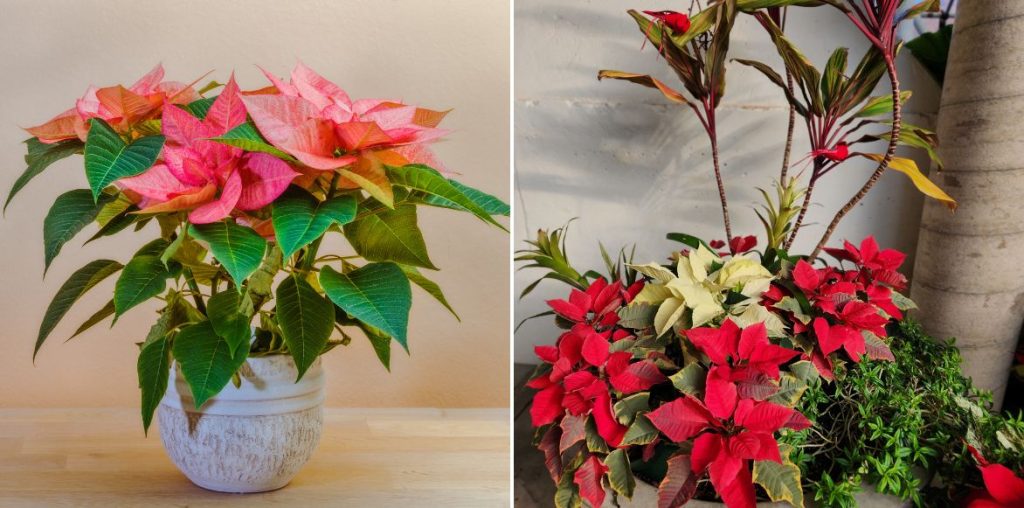
The Poinsettia often stands beautifully on its own, but you can also create lovely potted arrangements with several different varieties.
Also worth reading...
→ Discover our wide range of houseplants.
- Subscribe!
- Contents
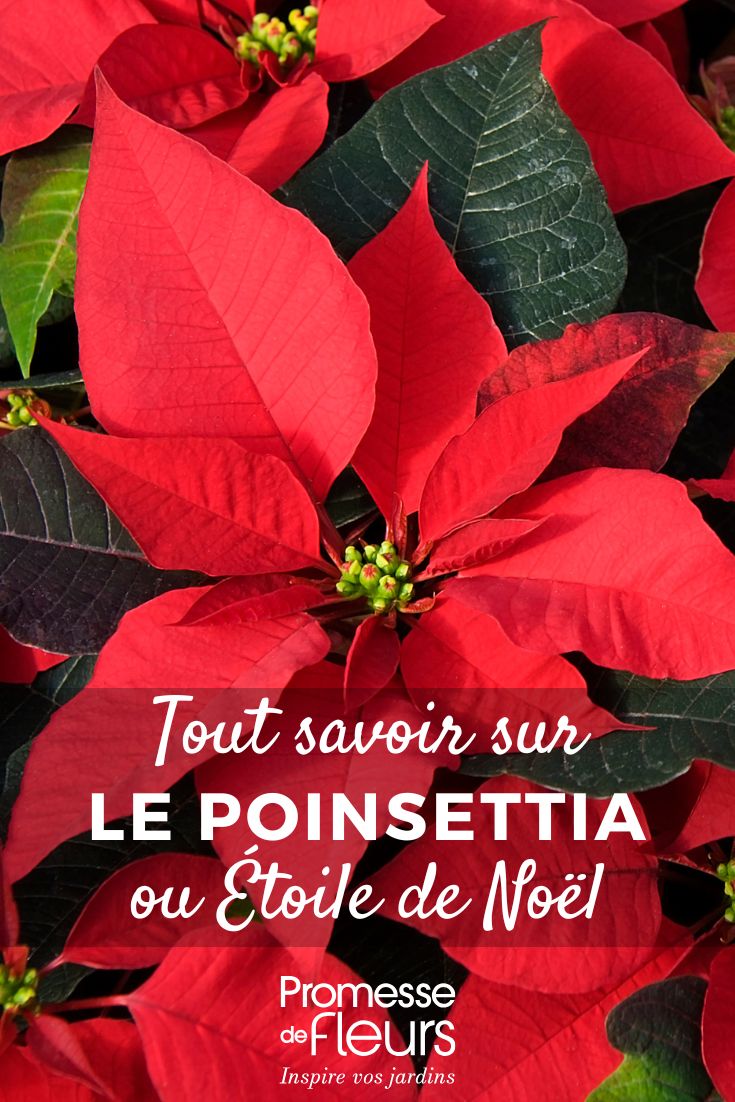































Comments